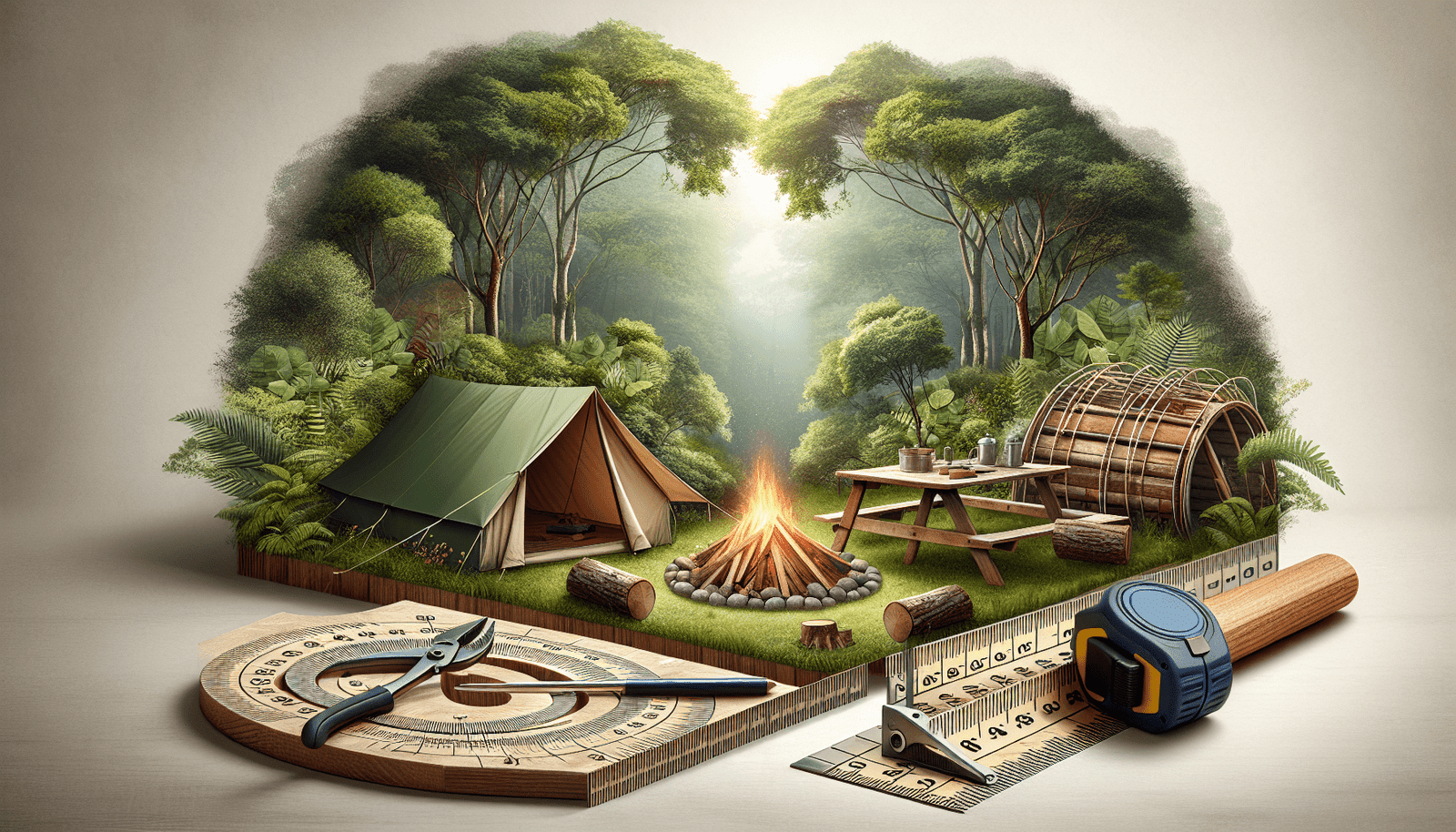Welcome to your guide on understanding the measurements of a campsite! In this article, you’ll dive into the specifics of campsite dimensions, exploring what you need to know to pick the perfect spot for your outdoor adventures. You’ll discover how to evaluate space for tents, vehicles, and additional gear, ensuring your campsite is both comfortable and functional. Whether you’re a seasoned camper or just getting started, this detailed overview will equip you with the knowledge to make your campsite setup smooth and enjoyable.
What Is The Measurement Of A Campsite?
Have you ever wondered, “What is the measurement of a campsite?” If you’ve ever ventured into the great outdoors, either as a novice camper or a seasoned backpacker, understanding campsite measurements can make your stay more comfortable and enjoyable. Let’s unravel the mysteries behind campsite dimensions, providing you with all the details you need to become an expert camper.

Understanding Campsite Measurements
Why Are Campsite Measurements Important?
Why should you even care about the measurements of a campsite? Well, the dimensions of your campsite play a significant role in determining how comfortable and functional your camping experience will be. Knowing the size can help you plan where to set up your tent, park your RV, or gather around the campfire.
Getting the measurements right ensures you have adequate space for all your gear and companions. Not to mention, it can also help in complying with the rules and guidelines set by campgrounds.
Standard Campsite Sizes
There isn’t a one-size-fits-all model when it comes to campsites. Depending on where you are camping, the provided measurements can vary significantly. However, there are some common standards that can give you a rough idea of what to expect.
Below is a table showing general campsite dimensions for tent camping and RV camping:
| Campsite Type | Width (in feet) | Length (in feet) |
|---|---|---|
| Tent Campsite | 10-15 | 10-20 |
| RV Campsite | 20-30 | 40-60 |
These dimensions are approximate but offer a good starting point for planning your trip.
Tent Campsite Measurements
Tent-Specific Considerations
When selecting a tent campsite, you’ll want to consider several factors beyond just the raw measurements. The terrain, slope, and nearby amenities also play crucial roles. Tent campsites cater mainly to people setting up one or more tents, and the space provided needs to accommodate the tent’s footprint and an additional area for activities and gear storage.
How to Measure Your Tent Footprint
To make sure your tent fits comfortably in a campsite, you need to measure its footprint accurately. Here’s how:
- Spread Out the Tent: Lay the tent flat on the ground.
- Measure the Length and Width: Use a tape measure to determine the length and width at the widest points.
- Add Buffer Space: Add 1-2 feet on each side to ensure you have enough room to move around the tent.
Example Scenario
Say you have a tent that measures 8 feet by 10 feet. Adding a buffer space of 2 feet around, the required campsite area would be:
| Measurement | Value |
|---|---|
| Tent Length | 8 feet |
| Tent Width | 10 feet |
| Buffer Space | 2 feet each side |
Minimum campsite dimensions = 12 feet x 14 feet.
RV Campsite Measurements
RV-Specific Considerations
Unlike tents, RVs have different spatial needs. RV campsites need to accommodate not just the vehicle itself, but also space for slide-outs, awnings, and outdoor setups like tables and chairs.
How to Measure Your RV Setup
To ensure you get the right RV campsite, measure your RV and consider any additional space requirements:
- Measure the Length and Width: Determine the vehicle’s length and width, including any tow bars or bike racks.
- Include Slide-Outs: If your RV has slide-outs, measure the full extended width.
- Outdoor Space: Plan for an additional outdoor space of at least 8-10 feet wide for setups like tables and chairs.
Example Scenario
Suppose your RV measures 25 feet in length and 10 feet in width, and includes slide-outs that extend an additional 3 feet on either side. Your setup might need:
| Measurement | Value |
|---|---|
| RV Length | 25 feet |
| RV Width | 10 feet (without slide-outs) |
| Slide-Out Width | 3 feet each side |
| Outdoor Space | 8 feet additional width |
Minimum campsite dimensions = 31 feet x 16 feet.
Slope and Terrain
Why Slope Matters
Even if a campsite has the right measurements on paper, the slope and terrain may affect its usability. A site that is too steep can cause drainage issues and make sleeping uncomfortable.
Measuring Slope
To measure the slope of a campsite:
- Use a Clinometer: A clinometer can provide the angle of the slope.
- Estimate by Eye: If you don’t have a clinometer, you can often estimate by eye or by placing a long object like a stick or tent pole horizontally and measuring the angle with a smartphone app.
Ideal Slope Conditions
Aim for a site with minimal slope for best results:
| Type of Slope | Description |
|---|---|
| Flat | Ideal for tents and lightweight camping setups |
| Slight Slope | Acceptable, especially for larger setups requiring drainage |
| Steep | Unsuitable, primarily because it compromises comfort and stability |

Ground Material and Vegetation
Ground Material Types
Different types of ground material can significantly impact your camping experience. Here’s a quick look at the common ground materials:
| Ground Material | Pros | Cons |
|---|---|---|
| Grass | Soft, comfortable | Can get muddy |
| Sand | Good drainage, easy setup | Can be difficult to secure stakes |
| Gravel | Excellent drainage | Hard on tent floors |
| Dirt | Easy setup | Can get very muddy, poor drainage |
Vegetation Considerations
The type of vegetation around your campsite can affect privacy and the overall ambiance. Dense trees can provide shade and windbreaks, while open areas might offer better views and easier stargazing opportunities.
Measuring and Preparing Ground Material
Ensure that the ground material is appropriate for your setup. For example, if you’re setting up on gravel, consider using thicker sleeping pads or extra ground tarps for comfort.
Environmental Factors
Proximity to Water
Camping near water sources like rivers, lakes, or streams can be convenient, but it comes with its own measures. Typically, campsites should be at least 200 feet away from any water source to minimize erosion and to respect public land regulations.
Distance from Trails and Roads
A good rule of thumb is to set up your campsite at least 100 feet away from trails and roads. This helps in reducing the impact on foot traffic areas and enhances your privacy and safety.
Campsite Layout and Organization
Planning Your Layout
Careful planning can help you maximize your available space and improve overall comfort. Consider the following elements for layout planning:
- Tent Placement: Place your tent on the flattest area.
- Cooking Area: Set up the cooking area downwind of your sleeping area.
- Fire Pit: Ensure at least a 10-foot radius clear of vegetation around the fire pit.
Using Tape or Markers
Use tape or natural markers to outline your space before setting up. This way, you can easily visualize and adjust the layout for optimal use.
Sample Layout
Here’s a sample layout for a 20×20 feet tent campsite:
| Element | Placement |
|---|---|
| Tent | Center towards one end |
| Cooking Area | 5-10 feet downwind from tent |
| Fire Pit | 10 feet from all structures |
| Gear Storage | Near tent, opposite side of cooking area |
Regulatory Guidelines
Camping Regulations by Region
Different regions may have their own guidelines when it comes to campsite measurements and usage. Always check with local agencies or the specific park’s regulations before setting up.
Leave No Trace Principles
Following Leave No Trace principles is essential to preserve the beauty and health of the wilderness:
- Plan Ahead: Ensuring your campsite measurements comply with local guidelines.
- Travel and Camp on Durable Surfaces: Avoid damaging the ground material.
- Dispose of Waste Properly: Pack out all trash.
- Minimize Campfire Impact: Use existing fire rings and follow fire safety guidelines.
- Respect Wildlife: Store food securely and maintain a safe distance from animals.
- Be Considerate of Others: Respect other campers’ space and peace.
Conclusion
So, what is the measurement of a campsite? It’s more than just a number; it’s a comprehensive understanding of all the factors that contribute to a comfortable and enjoyable camping experience. From the minimum dimensions needed for your tent or RV, to the ground material and slope, every detail matters.
By considering these guidelines and tips, you’ll be better prepared for your next outdoor adventure. Happy camping!
